List of Cultural Properties of Japan - paintings (Nara)
This list is of the Cultural Properties of Japan designated in the category of paintings (絵画, kaiga) for the Prefecture of Nara.[1]
National Cultural Properties
As of 1 July 2019, one hundred and sixty Important Cultural Properties have been designated (including eighteen *National Treasures), being of national significance.[2][3][4]
| Property | Date | Municipality | Ownership | Comments | Image | Dimensions | Coordinates | Ref. |
|---|---|---|---|---|---|---|---|---|
| *Amida Triad with Boy Attendant, colour on silk 絹本著色阿弥陀三尊及童子像 kenpon chakushoku Amida sanzon oyobi dōji zō | Heian period | Nara | Hokke-ji | three scrolls | 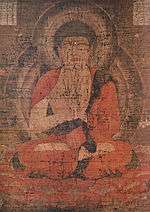   | 34°41′32″N 135°48′15″E | ||
| *Riding an Ox, colour on silk, by Li Di 絹本著色帰牧図〈李迪筆/(騎牛)〉 kenpon chakushoku kiboku zu (Li Di hitsu kigyū) | Southern Song | Nara | Kintetsu (kept at the Yamato Bunkakan) | .jpg) | 24.2 centimetres (9.5 in) by 23.8 centimetres (9.4 in) | 34°41′43″N 135°45′24″E | ||
| *Kusha Mandala, colour on silk 絹本著色倶舎曼荼羅図 kenpon chakushoku Kusha mandara zu | Heian period | Nara | Tōdai-ji | 34°41′20″N 135°50′24″E | ||||
| *Jion Daishi, colour on silk 絹本著色慈恩大師像 kenpon chakushoku Jion Daishi zō | Heian period | Nara | Yakushi-ji |  | 161.2 centimetres (63.5 in) by 129.2 centimetres (50.9 in) | 34°40′07″N 135°47′04″E | ||
| *Jūichimen Kannon, colour on silk 絹本著色十一面観音像 kenpon chakushoku jūichimen Kannon zō | Heian period | Nara | National Institutes for Cultural Heritage (kept at Nara National Museum) | 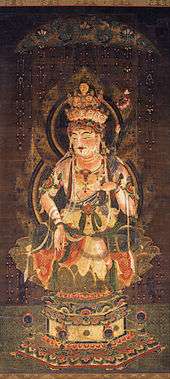 | 168.8 centimetres (66.5 in) by 89.6 centimetres (35.3 in) | 34°40′59″N 135°50′17″E | ||
| *Twelve Devas, colour on silk 絹本著色十二天像 kenpon chakushoku jūniten zō | Heian period | Nara | Saidai-ji | twelve scrolls | 160.0 centimetres (63.0 in) by 134.5 centimetres (53.0 in) | 34°41′37″N 135°46′46″E | ||
| *Wall Paintings of Takamatsuzuka Kofun 高松塚古墳壁画 Takamatsuzuka kofun hekiga | c.700 | Asuka | MEXT | four walls | 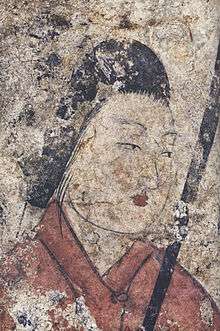 | 34°27′44″N 135°48′23″E | ||
| *Mandala of the Two Realms, gold and silver paint on indigo ground (Kojima Mandala) 紺綾地金銀泥絵両界曼荼羅図〈/(子島曼荼羅)〉 konayaji kingin dei-e ryōkai mandara zu (Kojima mandara) | Heian period | Nara | Kojima-dera (子島寺) (kept at Nara National Museum) | pair of scrolls |  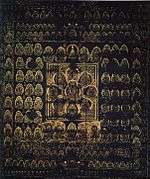 | 351.3 centimetres (138.3 in) by 297.0 centimetres (116.9 in), 349.1 centimetres (137.4 in) by 307.9 centimetres (121.2 in) | 34°40′59″N 135°50′17″E | |
| *Manners and Customs, colour on paper with gold ground, byōbu 紙本金地著色風俗図〈/六曲屏風〉 shihon kinji chakushoku fūzoku zu (rokkyoku byōbu) | Edo period | Nara | Kintetsu (kept at the Yamato Bunkakan) | pair of screens |   | 155.6 centimetres (61.3 in) by 361.6 centimetres (142.4 in) | 34°41′43″N 135°45′24″E | |
| *Sudhana's Pilgrimage to Fifty-five Spiritual Teachers as described in the Flower Garland Sutra, colour on paper 紙本著色華厳五十五所絵巻 shihon chakushoku kegon gojūgosho emaki | Heian period | Nara | Tōdai-ji | .jpg) | 29.8 centimetres (11.7 in) by 1,287.0 centimetres (42 ft 2.7 in) | 34°41′20″N 135°50′24″E | ||
| *Shigisan-engi, colour on paper 紙本著色信貴山縁起 shihon chakushoku Shigisan-engi | Heian period | Heguri | Chōgosonshi-ji (朝護孫子寺) | three scrolls | 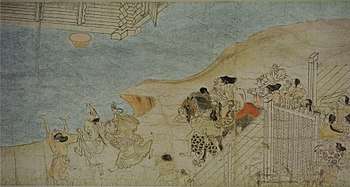 | 31.5 centimetres (12.4 in) by 827 centimetres (27 ft 2 in), 31.25 centimetres (12.30 in) by 1,270.3 centimetres (41 ft 8.1 in), 31.5 centimetres (12.4 in) by 1,416 centimetres (46 ft 5 in) | 34°41′20″N 135°50′24″E | |
| *Nezame Monogatari, colour on paper with gold ground, emaki 紙本著色寝覚物語絵巻 shihon chakushoku Nezame Monogatari emaki | Heian period | Nara | Kintetsu (kept at the Yamato Bunkakan) |  | 26 centimetres (10 in) by 533 centimetres (17 ft 6 in) | 34°41′43″N 135°45′24″E | ||
| *Hell Scroll, colour on paper 紙本著色地獄草紙 shihon chakushoku jigoku sōshi | Kamakura period | Nara | National Institutes for Cultural Heritage (kept at Nara National Museum) |  | 26.5 centimetres (10.4 in) by 454.7 centimetres (14 ft 11.0 in) | 34°40′59″N 135°50′17″E | ||
| *Extermination of Evil, colour on paper 紙本著色辟邪絵 shihon chakushoku hekija-e | Kamakura period | Nara | National Institutes for Cultural Heritage (kept at Nara National Museum) | five scrolls | 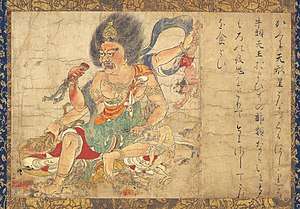 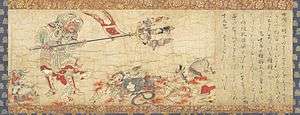 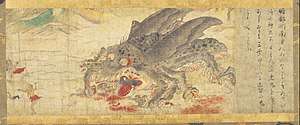 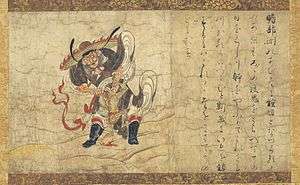 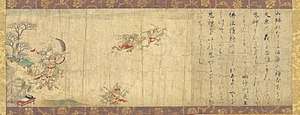 | 25.8 centimetres (10.2 in) to 26.0 centimetres (10.2 in) by 39.2 centimetres (15.4 in) to 77.2 centimetres (30.4 in) | 34°40′59″N 135°50′17″E | |
| *Landscape, ink and light colour on paper, attributed to Shūbun 紙本墨画淡彩山水図〈伝周文筆/〉 shihon bokuga tansai sansui zu (den-Shūbun hitsu) | 1445 | Nara | National Institutes for Cultural Heritage (kept at Nara National Museum) | dated to Bun'an 2 by the postscript to the third of the accompanying poems[5] |  | 108.0 centimetres (42.5 in) by 32.7 centimetres (12.9 in) | 34°40′59″N 135°50′17″E | |
| *Taishakuten Mandala, colour on wooden boards 板絵著色伝帝釈天曼荼羅図(金堂来迎壁) ita-e chakushoku den-Taishakuten mandara zu (kondō raigō heki) | Heian period | Uda | Murō-ji | in the Kondō | 34°32′16″N 136°02′26″E | |||
| *Kichijōten, colour on hemp cloth 麻布著色吉祥天像 mafu chakushoku Kichijōten zō | Nara period | Nara | Yakushi-ji | 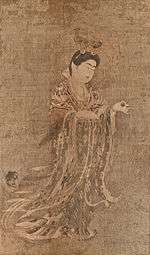 | 53.0 centimetres (20.9 in) by 31.7 centimetres (12.5 in) | 34°40′06″N 135°47′04″E | ||
| *Wall Paintings of Kitora Kofun キトラ古墳壁画 Kitora kofun hekiga | c.700 | Asuka | MEXT | 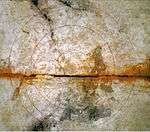 | 34°27′06″N 135°48′18″E | |||
| Former Jimon-in Partition Paintings, by Sakaki Hyakusen 旧慈門院障壁画〈彭城百川筆/宝暦元年四月の年記がある〉 kyū-Jimon-in shōhekiga | 1751 | Nara | private (kept at Nara National Museum) | 37 panels | 34°40′59″N 135°50′17″E | |||
| Wall Paintings from the Outer Sanctuary of the Kondō 金堂外陣旧壁画(土壁) kondō gejin kyū-hekiga | Nara period | Ikaruga | Hōryū-ji | 12 panels | 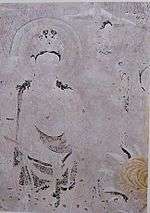 | 34°36′52″N 135°44′14″E | ||
| Wall Paintings from the Inner Sanctuary of the Kondō 金堂内陣旧壁画(土壁) kondō naijin kyū-hekiga | Nara period | Ikaruga | Hōryū-ji | 20 panels | 34°36′52″N 135°44′14″E | |||
| Dream Journey to the Peach Blossom Land, light colour on silk, by An Gyeon 絹本淡彩夢遊桃源図〈安堅筆/〉 kenpon tansai muyū tōgen zu (An Gyeon hitsu) | 1447 | Tenri | Tenri Central Library | pair of Joseon hand scrolls; the painting is accompanied by poetry and prose by twenty-one leading writers; the inscription by Prince Anpyeong (third son of Sejong the Great) reads "I am a person who dedicates his body to the palace day and night looking after affairs of state, so how is it that I went to the mountains and forests in my dreams?" Tao Yuanming's utopian Peach Blossom Spring provides the ideological underpinning to the dream[6] | 34°35′41″N 135°50′47″E | |||
| Descent of Amida and his Retinue, colour on silk 絹本著色阿弥陀聖衆来迎図 kenpon chakushoku Amida shōjū raigō zu | Kamakura period | Yamatokōriyama | Matsuo-dera (松尾寺) | 34°38′03″N 135°43′41″E | ||||
| Descent of Amida with Twenty-Five Bosatsu, colour on silk 絹本著色阿弥陀二十五菩薩来迎図 kenpon chakushoku Amida nijūgo bosatsu raigō zu | Kamakura period | Nara | Kōfuku-in (興福院) | 34°41′42″N 135°49′21″E | ||||
| Descent of Amida, colour on silk 絹本著色阿弥陀来迎図 kenpon chakushoku Amida raigō zu | Heian period | Sakurai | Hase-dera | 34°32′09″N 135°54′25″E | ||||
| Aizen Myōō, colour on silk 絹本著色愛染明王像 kenpon chakushoku Aizen Myōō zō | Heian period | Kyoto | Hosomi Art Foundation (kept at Hosomi Museum) | .jpg) | 35°00′50″N 135°46′47″E | |||
| Aizen Myōō, colour on silk 絹本著色愛染明王像 kenpon chakushoku Aizen Myōō zō | Kamakura period | Ikoma | Hōzan-ji | .jpg) | 142.1 centimetres (55.9 in) by 87.5 centimetres (34.4 in) | 34°41′04″N 135°41′12″E | ||
| Andō En'e, colour on silk 絹本著色安東円恵像 kenpon chakushoku Andō Enne zō | 1330 | Nara | National Institutes for Cultural Heritage (kept at Nara National Museum) | warlord depicted as a Zen priest[7] | .jpg) | 119.5 centimetres (47.0 in) by 57.9 centimetres (22.8 in) | 34°40′59″N 135°50′17″E | |
| Mandala of the One-Syllable Golden Wheel, colour on silk 絹本著色一字金輪曼荼羅図 kenpon chakushoku ichiji kenrin mandara zu | Kamakura period | private | ||||||
| Mandala of the One-Syllable Golden Wheel, colour on silk 絹本著色一字金輪曼荼羅図 kenpon chakushoku ichiji kenrin mandara zu | Kamakura period | Takatori | Minami Hokke-ji (南法華寺) | 34°25′35″N 135°48′35″E | ||||
| Mandala of the One-Syllable Golden Wheel, colour on silk 絹本著色一字金輪曼荼羅図 kenpon chakushoku ichiji kenrin mandara zu | Heian period (C12) | Nara | National Institutes for Cultural Heritage (kept at Nara National Museum) | Dainichi Kinrin seated on a lion pedestal with a treasure wheel and the seven treasures of a universal ruler[8][9] | .jpg) | 79.0 centimetres (31.1 in) by 49.5 centimetres (19.5 in) | 34°40′59″N 135°50′17″E | |
| Kashō Daishi, colour on silk Jōei Daishi, colour on silk 絹本著色嘉祥大師像 絹本著色浄影大師像 kenpon chakushoku Kashō Daishi zō kenpon chakushoku Jōei Daishi zō | Kamakura period | Nara | Tōdai-ji | .jpg) .jpg) | 34°41′20″N 135°50′24″E | |||
| Spiritual Teachers of the Kegon Ocean Assembly, colour on silk 絹本著色華厳海会善知識曼荼羅図 kenpon chakushoku Kegon kai-e zenchishiki mandara zu | 1294 | Nara | Tōdai-ji | .jpg) | 34°41′20″N 135°50′24″E | |||
| Kasagi Mandala, colour on silk 絹本著色笠置曼荼羅図 kenpon chakushoku Kasagi mandara zu | Kamakura period | Nara | Kintetsu (kept at the Yamato Bunkakan) | .jpg) | 34°41′43″N 135°45′24″E | |||
| Daylilies and Dogs at Play, colour on silk, attributed to Mao Yi 絹本著色萱草遊狗図〈(伝毛益筆)/〉 kenpon chakushoku kanzō yūku zu (den-Mōeki hitsu) | Southern Song | Nara | Kintetsu (kept at the Yamato Bunkakan) | .jpg) | 25.3 centimetres (10.0 in) by 25.7 centimetres (10.1 in) | 34°41′43″N 135°45′24″E | ||
| Kankyō Jūroku Kansō, colour on silk 絹本著色観経十六観相図 kenpon chakushoku kankyō jūroku kansō zu | Kamakura period | Nara | Amida-ji (阿弥陀寺) | 34°40′40″N 135°49′36″E | ||||
| Yoshino Mandala, colour on silk 絹本著色吉野曼荼羅図 kenpon chakushoku Yoshino mandara zu | Kamakura period | Nara | Saidai-ji (kept at Nara National Museum) | .jpg) | 34°40′59″N 135°50′17″E | |||
| Kokūzō Bosatsu, colour on silk 絹本著色虚空蔵菩薩像 kenpon chakushoku ichiji kenrin mandara zu | Kamakura period (C14) | Nara | National Institutes for Cultural Heritage (kept at Nara National Museum) | the cloud arising from the bodhisattva's head and the landscape below are unusual features[10] | _(Nara_National_Museum).jpg) | 77.0 centimetres (30.3 in) by 38.5 centimetres (15.2 in) | 34°40′59″N 135°50′17″E | |
| Nine Grades Raigō, colour on silk 絹本著色九品来迎図 kenpon chakushoku kubon raigō zu | Kamakura period | Shimoichi | Ryujō-ji (滝上寺) | three scrolls | .jpg) | 34°21′31″N 135°47′38″E | ||
| Sword with the Dragon Kurikara and Two Child Acolytes, colour on silk Mandala of the Two Realms, colour on silk 絹本著色倶利伽羅竜剣二童子像 絹本著色両界曼荼羅図 kenpon chakushoku Kurikara-ryū ni dōji zō kenpon chakushoku ryōgai mandara zu | Kamakura period | Nara | National Institutes for Cultural Heritage (kept at Nara National Museum) | from Sefuku-ji (施福寺)[11] | .jpg) .jpg) .jpg) | 34°40′59″N 135°50′17″E | ||
| Kumano Mandala, colour on silk 絹本著色熊野曼荼羅図 kenpon chakushoku Kumano mandara zu | Kamakura period | Nara | Agency for Cultural Affairs (kept at Nara National Museum) | .jpg) | 113.8 centimetres (44.8 in) by 50.6 centimetres (19.9 in) | 34°40′59″N 135°50′17″E | ||
| Five-Letter Monju, colour on silk 絹本著色五字文殊像 kenpon chakushoku goji Monju zō | 1334 | Nara | National Institutes for Cultural Heritage (kept at Nara National Museum) | by Shingon priest Monkanbō Kōshin (文観房弘真) (1278-1357)[12] | .jpg) | 90.8 centimetres (35.7 in) by 41.6 centimetres (16.4 in) | 34°40′59″N 135°50′17″E | |
| Gohonzon, colour on silk 絹本著色五尊像 kenpon chakushoku goson zō | Kamakura period | Ikaruga | Hōryū-ji | .jpg) | 34°36′51″N 135°44′08″E | |||
| Five Great Myōō, colour on silk 絹本著色五大明王像 kenpon chakushoku go dai Myōō zō | Kamakura period | Nara | National Institutes for Cultural Heritage (kept at Nara National Museum) | Fudō in the centre, with Gōzanze to the bottom right (East) and, clockwise, Gundari, Daiitoku, and Kongōyasha[13] | _(Nara_National_Museum).jpg) | 125.5 centimetres (49.4 in) by 86.7 centimetres (34.1 in) | 34°40′59″N 135°50′17″E | |
| Kujaku Myōō, colour on silk 絹本著色五尊像 kenpon chakushoku Kujaku Myōō zō | Heian period | Ikaruga | Hōryū-ji | .jpg) | 34°36′51″N 135°44′08″E | |||
| Fazang, colour on silk 絹本著色香象大師像 kenpon chakushoku Kōzō Daishi zō | Kamakura period | Nara | Tōdai-ji | .jpg) | 34°41′20″N 135°50′24″E | |||
| Four Saintly Persons, colour on silk 絹本著色四聖御影 kenpon chakushoku shi shō no miei | 1256/1377 | Nara | Tōdai-ji | key figures in the history of Tōdai-ji: Emperor Shōmu (rear left), Rōben (front left), Bodhisena (rear right), and Gyōki (front right); by Hokkyō Kanjō (法橋観盛) from Mino Province; 1377 copy of the 1256 version pictured | _Todaiji.jpg) | 34°41′20″N 135°50′24″E | ||
| Jion Daishi, colour on silk 絹本著色慈恩大師像 kenpon chakushoku Jion Daishi zō | Heian period | Nara | Kōfuku-ji | from the Daijō-in (大乗院)[14] | 242.2 centimetres (7 ft 11.4 in) by 124.2 centimetres (4 ft 0.9 in) | 34°40′58″N 135°49′56″E | ||
| Jion Daishi, colour on silk 絹本著色慈恩大師像 kenpon chakushoku Jion Daishi zō | Heian period | Nara | Kōfuku-ji | from the Ichijō-in (一乗院); dated by the temple to the Kamakura period[14] | .jpg) | 179.5 centimetres (70.7 in) by 80.6 centimetres (31.7 in) | 34°40′58″N 135°49′56″E | |
| Shaka Triad, colour on silk 絹本著色釈迦三尊像 kenpon chakushoku Shaka sanzon zō | Kamakura period (C14) | Nara | National Institutes for Cultural Heritage (kept at Nara National Museum) | three scrolls; Shaka Nyorai flanked by Monju Bosatsu and Fugen Bosatsu, showing strong Chinese influence; from Shōjuraigō-ji (聖衆来迎寺) in Ōtsu[15] | .jpg) .jpg) .jpg) | 117.0 centimetres (46.1 in) by 58.2 centimetres (22.9 in) | 34°40′59″N 135°50′17″E | |
| Shaka Triad, colour on silk 絹本著色釈迦三尊像(仁王会本尊) kenpon chakushoku Shaka sanzon zō (Ninnō-e honzon) | Kamakura period | Nara | Saidai-ji | Ninno-e honzon | 34°41′37″N 135°46′46″E | |||
| Shaka with Eight Great Bodhisattvas, colour on silk 絹本著色釈迦八大菩薩像 kenpon chakushoku Shaka hachi dai bosatsu zō | 1320 | Yamatokōriyama | Matsuo-dera (松尾寺) | Goryeo Buddhist painting | .jpg) | 177.3 centimetres (69.8 in) by 91.2 centimetres (35.9 in) | 34°38′03″N 135°43′41″E | |
| Shaka Preaching at Vulture Peak, colour on silk 絹本著色釈迦霊鷲山説法図 kenpon chakushoku Shaka Ryōjusen seppō | Kamakura period | Nara | National Institutes for Cultural Heritage (kept at Nara National Museum) | with a blue-green landscape setting[16] | .jpg) | 157.8 centimetres (62.1 in) by 78.2 centimetres (30.8 in) | 34°40′59″N 135°50′17″E | |
| Jūichimen Kannon, colour on silk 絹本著色十一面観音像 kenpon chakushoku jūichimen Kannon zō | Kamakura period | Nara | Tōdai-ji | 34°41′20″N 135°50′24″E | ||||
| Ten Kings of Hell, colour on silk, by Riku Shinchū 絹本著色十王図〈陸信忠筆/〉 kenpon chakushoku jūō zu (Riku Shinchū hitsu) | Yuan dynasty | Nara | National Institutes for Cultural Heritage (kept at Nara National Museum) | ten scrolls; alternatively dated to the Southern Song[17] | .jpg) | 83.2 centimetres (32.8 in) by 47.0 centimetres (18.5 in) | 34°40′59″N 135°50′17″E | |
| Ten Kings of Hell, colour on silk, by Riku Chūen 絹本著色十王像〈陸忠淵筆/閻羅王、泰山王、五道転輪王〉 kenpon chakushoku jūō zu (Riku Chūen hitsu) | Yuan dynasty | Nara | National Institutes for Cultural Heritage (kept at Nara National Museum) | three scrolls[18] | .jpg) 3.jpg) .jpg) | 85.9 centimetres (33.8 in) by 50.8 centimetres (20.0 in) | 34°40′59″N 135°50′17″E | |
| Twelve Devas, colour on silk, by Riku Chūen 絹本著色十二天像 kenpon chakushoku jūniten zō | Kamakura period | Nara | National Institutes for Cultural Heritage (kept at Nara National Museum) | twelve scrolls; Bonten pictured[19] | .jpg) | 122.7 centimetres (48.3 in) by 41.8 centimetres (16.5 in) | 34°40′59″N 135°50′17″E | |
| Sixteen Arhats, colour on silk 絹本著色十六羅漢像 kenpon chakushoku jūroku rakan zō | Kamakura period | Nara | Tōshōdai-ji | 34°40′32″N 135°47′05″E | ||||
| Sixteen Arhats, colour on silk, eight-panel byōbu 絹本著色十六羅漢像 〈/八曲屏〉 kenpon chakushoku jūroku rakan zō | Kamakura period | Ikaruga | Hōryū-ji | pair of screens | 34°36′52″N 135°44′14″E | |||
| Kasuga Mandala, colour on silk 絹本著色春日曼荼羅図 kenpon chakushoku Kasuga mandara zu | Kamakura period | Sakurai | Nōman-in | 34°32′12″N 135°54′27″E | ||||
| Kasuga Mandala, colour on silk 絹本著色春日曼荼羅図 kenpon chakushoku Kasuga mandara zu | Nanboku-chō period | Ikoma | Hōzan-ji | .jpg) | 122.7 centimetres (48.3 in) by 54.3 centimetres (21.4 in) | 34°41′04″N 135°41′12″E | ||
| Pure Land Mandala, colour on silk 絹本著色浄土曼荼羅図 kenpon chakushoku jōdo mandara zu | Kamakura period | Sakurai | Hase-dera | 34°32′09″N 135°54′25″E | ||||
| Pure Land Mandala, colour on silk 絹本著色浄土曼荼羅図 〈(伝清海曼荼羅)/〉 kenpon chakushoku jōdo mandara zu (den-Seikai mandara) | Heian period (C12) | Nara | National Institutes for Cultural Heritage (kept at Nara National Museum) | formerly identified known as the Seikai Mandala[20] | .jpg) | 162.1 centimetres (63.8 in) by 134.0 centimetres (52.8 in) | 34°40′59″N 135°50′17″E | |
| Shinran Shōnin, colour on silk 絹本著色親鸞聖人像 kenpon chakushoku Shinran Shōnin zō | Nanboku-chō period | Nara | National Institutes for Cultural Heritage (kept at Nara National Museum) | in the top right corner is the poem 行者宿報設女犯 我成玉女身被犯 一生之間能莊嚴 臨終引導生極樂 and at the end of the scroll the inscription 信房御影[四句文尊円親王/繪浄賀法橋]naming the painter as Jōga (1275-1356); from Jōfuku-ji (常福寺) in Kyoto[21] | .jpg) | 120.2 centimetres (47.3 in) by 81.1 centimetres (31.9 in) | 34°40′59″N 135°50′17″E | |
| Star Mandala, colour on silk 絹本著色星曼荼羅図 kenpon chakushoku hoshi mandara zu | Heian period | Ikaruga | Hōryū-ji | .jpg) | 34°36′52″N 135°44′14″E | |||
| Star Mandala, colour on silk 絹本著色星曼荼羅図 kenpon chakushoku hoshi mandara zu | Heian period | Ikaruga | Hōryū-ji | 34°36′52″N 135°44′14″E | ||||
| Ikoma Mandala, colour on silk 絹本著色生駒曼荼羅図 kenpon chakushoku Ikoma mandara zu | Kamakura period | Nara | National Institutes for Cultural Heritage (kept at Nara National Museum) | depicting seven Buddhas above Ikoma Jinja, an example of the honji suijaku paradigm[22] | .jpg) | 105.3 centimetres (41.5 in) by 41.9 centimetres (16.5 in) | 34°40′59″N 135°50′17″E | |
| Shōkō Mandala, colour on silk, by Gyōson 絹本著色聖皇曼荼羅図〈尭尊筆/〉 kenpon chakushoku Shōkō mandara zu (Gyōson hitsu) | 1255 | Ikaruga | Hōryū-ji | .jpg) | 34°36′52″N 135°44′14″E | |||
| Descent of the Heavenly Multitude, colour on silk 絹本著色聖衆来迎図 kenpon chakushoku shōjū raigō zu | Kamakura period | Kashiba | Anichi-ji (阿日寺) | .jpg) | 95.0 centimetres (37.4 in) by 53.8 centimetres (21.2 in) | 34°31′57″N 135°42′22″E | ||
| Shōtoku Taishi Lecturing on the Shoman-kyō, colour on silk 絹本著色聖徳太子勝鬘経講讃図 kenpon chakushoku Shōtoku Taishi Shōman-kyō kōsan zu | Kamakura period (C13) | Ikaruga | Hōryū-ji | .jpg) | 210.5 centimetres (82.9 in) by 177.4 centimetres (69.8 in) | 34°36′52″N 135°44′14″E | ||
| Shōtoku Taishi, colour on silk 絹本著色聖徳太子像 kenpon chakushoku Shōtoku Taishi zō | Kamakura period | Ikaruga | Hōryū-ji | 34°36′52″N 135°44′14″E | ||||
| Senju Kannon, colour on silk 絹本著色千手観音像 kenpon chakushoku Senju Kannon zō | Kamakura period (C14) | Nara | National Institutes for Cultural Heritage (kept at Nara National Museum) | at the bottom of the image a dragon holding a sacred jewel rises from the waters[23] | .jpg) | 100.8 centimetres (39.7 in) by 41.0 centimetres (16.1 in) | 34°40′59″N 135°50′17″E | |
| Senju Sengen Kannon, colour on silk 絹本著色千手千眼観音像 kenpon chakushoku Senju Sengen Kannon zō | Kamakura period | Yoshino | Kimpusen-ji | 34°22′07″N 135°51′29″E | ||||
| Sonshō Mandala, colour on silk 絹本著色尊勝曼荼羅図 kenpon chakushoku sonshō mandara zu | Kamakura period | Nara | National Institutes for Cultural Heritage (kept at Nara National Museum) | from Myōō-in (明星院)[24] | .jpg) | 133.8 centimetres (52.7 in) by 82.3 centimetres (32.4 in) | 34°40′59″N 135°50′17″E | |
| Pictorial Biography of Shōtoku Taishi, colour on silk, attributed to Tosa Mitsunobu 絹本著色太子絵伝〈(伝土佐光信筆)/〉 kenpon chakushoku Taishi e-den (den-Tosa Mitsunobu hitsu) | Muromachi period | Asuka | Tachibana-dera | eight scrolls | 34°28′12″N 135°49′03″E | |||
| Daiitoku Myōō, colour on silk 絹本著色大威徳明王像 kenpon chakushoku Daiitoku Myōō zō | Heian period | Sakurai | Tanzan Jinja | 34°27′57″N 135°51′42″E | ||||
| Daiitoku Myōō, colour on silk 絹本著色大威徳明王像 kenpon chakushoku Daiitoku Myōō zō | Kamakura period | Nara | Tōshōdai-ji | 34°40′32″N 135°47′05″E | ||||
| Daibutchō Mandala, colour on silk 絹本著色大仏頂曼荼羅図 kenpon chakushoku Daibutchō mandara zu | Heian period (C12) | Nara | National Institutes for Cultural Heritage (kept at Nara National Museum) | devotional use of the Daibutchō mandala seems to have begun in the eleventh century[25] | .jpg) | 125.5 centimetres (49.4 in) by 88.5 centimetres (34.8 in) | 34°40′59″N 135°50′17″E | |
| Jizō and the Ten Kings of Hell, colour on silk 絹本著色地蔵十王像 kenpon chakushoku Jizō jūō zō | Kamakura period | Sakurai | Hase-dera | 34°32′09″N 135°54′25″E | ||||
| Jizō Bosatsu, colour on silk 絹本著色地蔵菩薩像 kenpon chakushoku Jizō Bosatsu zō | Kamakura period (C13) | Nara | National Institutes for Cultural Heritage (kept at Nara National Museum) | with a shakujō in his right hand and hōju or sacred gem in his left, standing upon a lotus pedestal atop a flying cloud[26] | _(Nara_National_Museum).jpg) | 101.0 centimetres (39.8 in) by 36.3 centimetres (14.3 in) | 34°40′59″N 135°50′17″E | |
| Jizō Bosatsu, colour on silk 絹本著色地蔵菩薩像 kenpon chakushoku Jizō Bosatsu zō | Kamakura period (C14) | Nara | National Institutes for Cultural Heritage (kept at Nara National Museum) | with a landscape background; from Chuzō-in (中蔵院) in Tamano, Okayama[27] | .jpg) | 92.1 centimetres (36.3 in) by 38.1 centimetres (15.0 in) | 34°40′59″N 135°50′17″E | |
| Nakamura Kuranosuke, colour on silk, by Ogata Kōrin 絹本著色中村内蔵助像〈尾形光琳筆/〉 kenpon chakushoku Nakamura Kuranosuke zō (Ogata Kōrin hitsu) | Edo period | Nara | Kintetsu (kept at the Yamato Bunkakan) | with poetic inscriptions dated to 1704 | .jpg) | 34°41′43″N 135°45′24″E | ||
| So-called Kakinomoto Miya Mandala, colour on silk 絹本著色伝柿本曼荼羅図 kenpon chakushoku den-Kakinomoto Miya mandara zu | Kamakura period | Nara | Kintetsu (kept at the Yamato Bunkakan) | designation includes a related document dating to 1476 | .jpg) | 34°41′43″N 135°45′24″E | ||
| Legends of the Taima Mandala, colour on silk 絹本著色当麻曼荼羅縁起 kenpon chakushoku Chūjō-hime zō | Nanboku-chō period | Katsuragi | Taima-dera | pair of scrolls | 34°30′58″N 135°41′40″E | |||
| Daoxuan, colour on silk 絹本著色道宣律師像 kenpon chakushoku Dōsen Risshi zō | Kamakura period (C14) | Nara | National Institutes for Cultural Heritage (kept at Nara National Museum) | wearing a black kesa[28] | .jpg) | 112.5 centimetres (44.3 in) by 56.2 centimetres (22.1 in) | 34°40′59″N 135°50′17″E | |
| White Path between Two Rivers, colour on silk 絹本著色二河白道図 kenpon chakushoku niga byakudō zu | Kamakura period (C14) | Nara | National Institutes for Cultural Heritage (kept at Nara National Museum) | a Pure Land allegory[29] | .jpg) | 71.0 centimetres (28.0 in) by 26.3 centimetres (10.4 in) | 34°40′59″N 135°50′17″E | |
| Two Heavenly Kings, colour on silk 絹本著色二天王像 kenpon chakushoku ni tennō zō | Kamakura period | Nara | Kōfuku-ji | Jikoku-ten pictured and Zōchō-ten | .jpg) | 135.5 centimetres (53.3 in) by 96.0 centimetres (37.8 in) | 34°40′58″N 135°49′56″E | |
| Hiei Sannō Miya Mandala, colour on silk 絹本著色日吉山王宮曼荼羅図 kenpon chakushoku Hie Sannō miya mandara zu | Nanboku-chō period | Nara | National Institutes for Cultural Heritage (kept at Nara National Museum) | with the twenty-one enshrined kami, and corresponding honjibutsu and seed syllables above[30] | .jpg) | 120.7 centimetres (47.5 in) by 68.1 centimetres (26.8 in) | 34°40′59″N 135°50′17″E | |
| Hiei Sannō Miya Mandala, colour on silk 絹本著色日吉山王宮曼荼羅図 kenpon chakushoku Hie Sannō miya mandara zu | Kamakura period | Nara | Kintetsu (kept at the Yamato Bunkakan) | .jpg) | 34°41′43″N 135°45′24″E | |||
| Nyoirin Kannon, colour on silk 絹本著色如意輪観音像 kenpon chakushoku Nyoirin Kannon zō | late Kamakura period | Nara | National Institutes for Cultural Heritage (kept at Nara National Museum) | with six arms and a gold body, as described in the Kanjizai Nyoi Bosatsu Yuga Hōyō (観自在菩薩如意輪瑜伽法要)[31] | .jpg) | 101.7 centimetres (40.0 in) by 41.6 centimetres (16.4 in) | 34°40′59″N 135°50′17″E | |
| White-Robed Kannon, colour on silk 絹本著色白衣観音図 kenpon chakushoku Byakue Kannon zu | 1377 | Nara | National Institutes for Cultural Heritage (kept at Nara National Museum) | white-robed and seated on a grass-covered rock; according to the fifth chapter of the Mahavairocana Sutra, the white is the "whiteness of the pure aspiration of enlightenment"; ink inscription in the upper right corner: 稽首淨聖甘露除焔 | 眞大依怙普施福縁 | 丁巳仲夏 | 壽峯海燁謹題; stylistic considerations date 丁巳 (Yin Fire Snake according to the Sexagenary cycle) to 1377; of Goryeo, Yuan or Ming origin[32][33][34] | .jpg) | 99.1 centimetres (39.0 in) by 40.3 centimetres (15.9 in) | 34°40′59″N 135°50′17″E | |
| Bishamon-ten, colour on silk 絹本著色毘沙門天像 kenpon chakushoku Bishamon-ten zō | Kamakura period | Nara | Kairyūō-ji (海龍王寺) | 34°41′34″N 135°48′20″E | ||||
| Bishamon-ten, colour on silk 絹本著色毘沙門天像 kenpon chakushoku Bishamon-ten zō | Kamakura period | Ikaruga | Hōryū-ji | 34°36′52″N 135°44′14″E | ||||
| Fudō Myōō and Eight Child Acolytes, colour on silk 絹本著色不動明王八大童子像 kenpon chakushoku Fudō Myōō hachidai dō zō | Kamakura period | Nara | National Institutes for Cultural Heritage (kept at Nara National Museum) | from Shakamon-in (釈迦文院) on Mount Kōya[35] | .jpg) | 129.6 centimetres (51.0 in) by 89.3 centimetres (35.2 in) | 34°40′59″N 135°50′17″E | |
| Fugen Enmei, colour on silk 絹本著色普賢延命像 kenpon chakushoku Fugen Enmei zō | Kamakura period | Nara | National Institutes for Cultural Heritage (kept at Nara National Museum) | from Shōren-in in Kyoto[36] | .jpg) | 91.3 centimetres (35.9 in) by 41.9 centimetres (16.5 in) | 34°40′59″N 135°50′17″E | |
| Fugen and the Ten Rasetsunyō, colour on silk 絹本著色普賢十羅刹女像 kenpon chakushoku Fugen jū rasetsunyō zō | Kamakura period | Nara | National Institutes for Cultural Heritage (kept at Nara National Museum) | the Rasetsunyō wear jūnihitoe[37] | .jpg) | 112.0 centimetres (44.1 in) by 55.0 centimetres (21.7 in) | 34°40′59″N 135°50′17″E | |
| Fugen Bosatsu, colour on silk 絹本著色普賢菩薩像 kenpon chakushoku Fugen Bosatsu zō | Heian period (C12) | Nara | National Institutes for Cultural Heritage (kept at Nara National Museum) | the episode where Fugen appears on a white elephant to protect the followers of the Lotus Sutra is from its Fugen Bosatsu kanhotsu hon (普賢菩薩勧発品)[38] | .jpg) | 62.0 centimetres (24.4 in) by 30.7 centimetres (12.1 in) | 34°40′59″N 135°50′17″E | |
| Buddha’s Parinirvana, colour on silk 絹本著色仏涅槃図 kenpon chakushoku Butsu nehan zu | Heian period | Uda | Sōyū-ji (宗祐寺) | three scrolls | 1.jpg) | 34°31′54″N 135°57′32″E | ||
| Buddha’s Parinirvana, colour on silk 絹本著色仏涅槃図 kenpon chakushoku Butsu nehan zu | Heian period | Nara | Shin-Yakushi-ji | 34°40′33″N 135°50′46″E | ||||
| Buddha’s Parinirvana, colour on silk 絹本著色仏涅槃図 kenpon chakushoku Butsu nehan zu | Yuan dynasty | Nara | National Institutes for Cultural Heritage (kept at Nara National Museum) | by Riku Shinchū (陸信忠); alternatively dated to the Southern Song[39] | .jpg) | 157.1 centimetres (61.9 in) by 82.9 centimetres (32.6 in) | 34°40′59″N 135°50′17″E | |
| Monju Bosatsu, colour on silk 絹本著色文殊菩薩像 kenpon chakushoku Monju Bosatsu zō | 1302 | Nara | Saidai-ji | .jpg) | 34°41′37″N 135°46′46″E | |||
| Hokke Mandala, colour on silk 絹本著色法華曼荼羅図 kenpon chakushoku Hokke mandara zu | Kamakura period | Nara | Tōshōdai-ji | .jpg) | 122.3 centimetres (48.1 in) by 86.2 centimetres (33.9 in) | 34°40′32″N 135°47′05″E | ||
| Hokke Mandala, colour on silk 絹本著色法華曼荼羅図 kenpon chakushoku Hokke mandara zu | Heian period | Ikaruga | Hōryū-ji | 34°36′52″N 135°44′14″E | ||||
| Musō Soseki, colour on silk Mukyoku Shigen, colour on silk 絹本著色夢窓疎石像 絹本著色無極志玄像 kenpon chakushoku Musō Soseki zō kenpon chakushoku Mukyoku Shigen zō | Nanboku-chō period | Jissai-in (慈済院) | .jpg) .jpg) | 112.3 centimetres (44.2 in) by 56.3 centimetres (22.2 in), 115.3 centimetres (45.4 in) by 61.1 centimetres (24.1 in) | ||||
| Myōkū, colour on silk 絹本著色明空法師像 kenpon chakushoku Myōkū hōshi zō | Kamakura period | Nara | National Institutes for Cultural Heritage (kept at Nara National Museum) | from Busshin-ji (仏心寺) in Shiga Prefecture[40] | .jpg) | 168.5 centimetres (66.3 in) by 100.2 centimetres (39.4 in) | 34°40′59″N 135°50′17″E | |
| Miroku Bosatsu, colour on silk 絹本著色弥勒菩薩像 kenpon chakushoku Miroku bosatsu zō | Kamakura period | Ikoma | Hōzan-ji | .jpg) | 164.2 centimetres (64.6 in) by 88.8 centimetres (35.0 in) | 34°41′04″N 135°41′12″E | ||
| Legends of Yata Jizō, colour on silk 絹本著色矢田地蔵縁起 kenpon chakushoku Yata Jizō engi | Kamakura period | Yamatokōriyama | Kongōsen-ji (金剛山寺) | pair of scrolls | .jpg) | 34°41′04″N 135°41′12″E | ||
| Illustrated Legends of Yūzū Nenbutsu, colour on paper 紙本著色融通念仏縁起絵 shihon chakushoku yūzū nenbutsu engi-e | Kamakura period | Tawaramoto | Anraku-ji (安楽寺) | .gif) | 34°32′37″N 135°46′51″E | |||
| Mandala of the Two Realms, colour on silk 絹本著色両界曼荼羅図〈厨子入/〉 kenpon chakushoku ryōgai mandara zu (zushi iri) | Kamakura period | Nara | National Institutes for Cultural Heritage (kept at Nara National Museum) | two paintings inside a portable shrine with doors to front and rear; from Shōjuraigō-ji (聖衆来迎寺) in Ōtsu[41] | .jpg) .jpg) | 18.3 centimetres (7.2 in) by 18.5 centimetres (7.3 in) | 34°40′59″N 135°50′17″E | |
| Lotus Pond, colour on silk, two-panel byōbu 絹本著色蓮池図〈(旧舎利殿須弥壇後壁貼付)/二曲屏風〉 kenpon chakushoku renchi zu | Kamakura period | Ikaruga | Hōryū-ji | from the real wall of the shumidan (altar) in the Shariden | 2.jpg) .jpg) | 34°36′52″N 135°44′14″E | ||
| Shishū Daishi, colour on silk 絹本著色泗州大師像 kenpon chakushoku Shishū Daishi zō | Kamakura period | Nara | Kōfuku-ji | .jpg) | 149.0 centimetres (58.7 in) by 124.2 centimetres (48.9 in) | 34°40′58″N 135°49′56″E | ||
| Buddha’s Parinirvana, colour on silk 絹本著色涅槃図 kenpon chakushoku nehan zu | Heian period | Ōji | Daruma-ji (達磨寺) | .jpg) | 34°35′23″N 135°42′25″E | |||
| Hollyhocks and Cats at Play, colour on silk, attributed to Mao Yi 絹本著色蜀葵遊猫図〈(伝毛益筆)/〉 kenpon chakushoku shokki yūbyō zu (den-Mōeki hitsu) | Southern Song | Nara | Kintetsu (kept at the Yamato Bunkakan) | 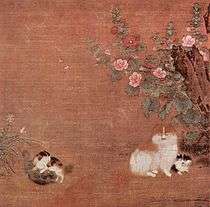 | 25.3 centimetres (10.0 in) by 25.8 centimetres (10.2 in) | 34°41′43″N 135°45′24″E | ||
| Water Moon Kannon, colour on silk 絹本墨画水月観音像 kenpon chakushoku suigetsu Kannon zō | Nanboku-chō period | Nara | National Institutes for Cultural Heritage (kept at Nara National Museum) | with poetic inscription by Tennan Myōju (天庵妙受)[42] | .jpg) | 88.0 centimetres (34.6 in) by 36.7 centimetres (14.4 in) | 34°40′59″N 135°50′17″E | |
| Landscape, ink and light colour on silk 絹本墨画淡彩山水図〈伝趙大年筆/〉 kenpon bokuga tansai sansui zu | Southern Song | Nara | Kintetsu (kept at the Yamato Bunkakan) | .jpg) | 34°41′43″N 135°45′24″E | |||
| White-Robed Kannon, ink on silk 絹本墨画白衣観音図 kenpon bokuga Byakue Kannon zu | Kamakura period | Nara | National Institutes for Cultural Heritage (kept at Nara National Museum) | the willow in a vase and water under a rock are iconographically similar to the Yōryū (Willow) Kannon and Suigetsu (Water Moon) Kannon[43] | .jpg) | 100.3 centimetres (39.5 in) by 41.4 centimetres (16.3 in) | 34°40′59″N 135°50′17″E | |
| Wall paintings of the Hōryū-ji Five-Storey Pagoda 五重塔初層旧壁画(土壁) gojū-no-tō shosō kyū-hekiga | Nara period | Ikaruga | Hōryū-ji | 18 panels on earthen render | 34°36′52″N 135°44′14″E | |||
| Defenders of the Law, door paintings 護法善神図絵扉 Gohō zenshin zue tobira | Kamakura period | Nara | Kōfuku-ji | from a six-sided miniature shrine (厨子) | 88.4 centimetres (34.8 in) by 30.2 centimetres (11.9 in) | 34°40′58″N 135°49′56″E | ||
| Lotus Sutra Hōtō Mandala, gold and silver paint on blue paper 紺紙金銀泥法華経宝塔曼荼羅図〈(開結共)/〉 konshi kingin dei Hokke-kyō hōtō mandara zu | Heian period | Sakurai | Tanzan Jinja | ten scrolls | 34°27′57″N 135°51′42″E | |||
| Fine Ox, light colour on paper 紙本淡彩駿牛図断簡 shihon tansai sungyū zu dankan | Kamakura period | private | ||||||
| Matamata Ichiraku jō, light colour on paper, by Tanomura Chikuden 紙本淡彩亦復一楽帖〈田能村竹田筆/〉 shihon Matamata Ichiraku jō (Tanomura Chikuden hitsu) | 1831 | Nara | Neiraku Museum | one album | .jpg) | 34°41′10″N 135°50′14″E | ||
| Ippen Shōnin, light colour on paper 紙本著色一遍上人絵巻 shihon chakushoku Ippen Shōnin emaki | Kamakura period | private | four scrolls | |||||
| Sudhana's Pilgrimage to Fifty-five Spiritual Teachers as described in the Flower Garland Sutra, colour on paper 紙本著色華厳五十五所絵 shihon chakushoku kegon gojūgosho e | Heian period | Nara | Tōdai-ji | ten scrolls | 34°41′20″N 135°50′24″E | |||
| Sudhana's Pilgrimage to Fifty-five Spiritual Teachers as described in the Flower Garland Sutra, colour on paper 紙本著色華厳五十五所絵 shihon chakushoku kegon gojūgosho e | Heian period | Nara | National Institutes for Cultural Heritage (kept at Nara National Museum) | one scroll; part of a set dispersed across Tōdai-ji, the Nezu Museum, and the Fujita Art Museum[44] | .jpg) | 74.7 centimetres (29.4 in) by 44.7 centimetres (17.6 in) | 34°40′59″N 135°50′17″E | |
| Illustrated Sutra of Cause and Effect, colour on paper 紙本著色絵因果経断簡〈巻第二上/(六十二行)〉 shihon chakushoku e-inga-kyō dankan | Nara period | Nara | National Institutes for Cultural Heritage (kept at Nara National Museum) | one scroll[45] | 16.4 centimetres (6.5 in) by 115.9 centimetres (45.6 in) | 34°40′59″N 135°50′17″E | ||
| Thirty-Six Immortals of Poetry, colour on paper (Kodai no Kimi) 紙本著色三十六歌仙切〈(小大君)/佐竹家伝来〉 shihon chakushoku sanjūrokkasen setsu (Koōkimi / Satake-ke denrai) | Kamakura period | Nara | Kintetsu (kept at the Yamato Bunkakan) | one scroll from the Satake Family Collection | .jpg) | 34°41′43″N 135°45′24″E | ||
| Ten Spiritual Realms, colour on paper, six-panel byōbu 紙本著色十界図〈/六曲屏風〉 shihon chakushoku jikkai zu (rokkyoku byōbu) | Muromachi period | Katsuragi | Oku-no-in | pair of screens | 34°31′00″N 135°41′37″E | |||
| Five Pure Land Patriarchs, colour on paper 紙本著色浄土五祖絵〈(曇鸞巻、善導巻)/〉 shihon chakushoku jōdo goso-e | Nanboku-chō period | private | Donran and Zendō | |||||
| Sesson, self-portrait, colour on silk 紙本著色雪村自画像 shihon chakushoku Sesson jigazō | Muromachi period | Nara | Kintetsu (kept at the Yamato Bunkakan) | 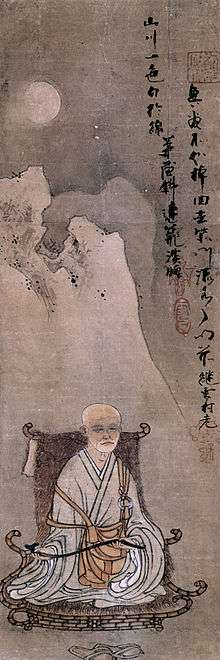 | 34°41′43″N 135°45′24″E | |||
| Sutra fan, colour on paper 紙本著色扇面古写経 shihon chakushoku senmen koshakyō | Heian period | Ikaruga | Hōryū-ji | 34°36′52″N 135°44′14″E | ||||
| Hell of Boiling Excrement, colour on paper 紙本著色地獄草紙断簡(沸屎地獄) shihon chakushoku jigoku zōshi dankan (Fusshi Jikoku) | late Heian period | Nara | National Institutes for Cultural Heritage (kept at Nara National Museum) | one scroll[46] | 26.3 centimetres (10.4 in) by 104.4 centimetres (41.1 in) | 34°40′59″N 135°50′17″E | ||
| The Eastern Journeys of Ganjin, colour on paper, by Rengyō 紙本著色東征絵巻〈蓮行筆/〉 shihon chakushoku tōsei emaki (Rengyō hitsu) | 1298 | Nara | Tōshōdai-ji | five handscrolls | 34°40′32″N 135°47′05″E | |||
| Legends of the Tōdai-ji Daibutsu, colour on paper 紙本著色東大寺大仏縁起〈芝琳賢筆/〉 shihon chakushoku Tōdaiji daibutsu engi (Shiba Rinken hitsu) | 1536 | Nara | Tōdai-ji | three scrolls | .jpg) | 34°41′20″N 135°50′24″E | ||
| Legends of Taima-dera, colour on paper 紙本著色当麻寺縁起 shihon chakushoku Taima-dera engi | 1629 | private | three scrolls | |||||
| Legends of Taima-dera, colour on paper, by Tosa Mitsumochi 紙本著色当麻寺縁起〈絵土佐光茂筆/詞後奈良天皇等九筆〉 shihon chakushoku Taima-dera engi (e Tosa Mitsumochi hitsu / shi Go-Nara tennō tō kyū hitsu〉 | 1531 | Katsuragi | Taima-dera | with poetic text in the hand of Emperor Go-Nara among others | 34°30′58″N 135°41′40″E | |||
| Portrait of a Lady, colour on silk 紙本著色婦人像 shihon chakushoku fujin zō | Momoyama period | Nara | Kintetsu (kept at the Yamato Bunkakan) | .jpg) | 34°41′43″N 135°45′24″E | |||
| Deeds of Hōnen, colour on paper, emaki 紙本著色法然上人行状絵巻 shihon chakushoku Hōnen jōnin gyōjō emaki | Kamakura period | Katsuragi | Oku-no-in | forty-eight scrolls | 34°31′00″N 135°41′37″E | |||
| Aristocratic Gathering in Kempo 6, monochrome ink on paper 紙本白描建保六年中殿御会図 hakubyō Kenpo rokunen chūden gyokai zu | Muromachi period | private | ||||||
| Genji Monogatari (Ukifune scroll), monochrome ink on paper 紙本白描源氏物語絵(浮舟巻残巻) shihon hakubyō Genji monogatari e (Ukifune maki zankan) | Kamakura period | Nara | Kintetsu (kept at the Yamato Bunkakan) | one fragmentary scroll bound in a book | .jpg) | 34°41′43″N 135°45′24″E | ||
| Iconographic Drawings of the Takao Mandala, monochrome ink on paper 紙本白描高雄曼荼羅図像(胎蔵界巻第一、三、四、五 金剛界巻第一、二) shihon hakubyō Takao mandara zuzō | Heian period | Sakurai | Hase-dera | six scrolls (Diamond Realm scrolls 1, 2; Womb Realm scrolls 1, 3, 4, 5) | 34°32′09″N 135°54′25″E | |||
| Iconographic Drawings of Kannon, monochrome ink on paper 紙本白描諸観音図像 shihon hakubyō sho Kannon zuzō | Heian period | Nara | National Institutes for Cultural Heritage (kept at Nara National Museum) | contains six forms of Kannon (Shō Kannon, Senju Kannon, Batō Kannon, Fukukenjaku Kannon, Byakue Kannon, and Nyoirin Kannon)[47] | 30.3 centimetres (11.9 in) by 1,064.3 centimetres (34 ft 11.0 in) | 34°40′59″N 135°50′17″E | ||
| Drawings of door paintings from the Tōdai-ji Kaidan-in, monochrome ink on paper 紙本白描東大寺戒壇院扉絵図 shihon hakubyō Tōdaiji Kaidan-in tobira-e zu | C12 | Nara | National Institutes for Cultural Heritage (kept at Nara National Museum) | thought to be a copy of the paintings on the doors of a portable shrine (厨子) dedicated in 755 and lost to the fires of 1180[48] | .jpg) | 28.9 centimetres (11.4 in) by 1,114.0 centimetres (36 ft 6.6 in) | 34°40′59″N 135°50′17″E | |
| Iconographic Drawings of Fudō Myōō, monochrome ink on paper 紙本白描不動明王図像 shihon hakubyō Fudō Myōō zuzō | 1245 | Nara | National Institutes for Cultural Heritage (kept at Nara National Museum) | includes images of Fudō Myōō, his acolytes, and his avatars[49] | 30.5 centimetres (12.0 in) by 1,232.6 centimetres (40 ft 5.3 in) | 34°40′59″N 135°50′17″E | ||
| Vimalakirti, colour on paper, by Bunsei 紙本墨画維摩居士像〈文清筆/長禄元年祖黙賛〉 shihon chakushoku Yuima Kōji zō (Bunsei hitsu) | 1457 | Nara | Kintetsu (kept at the Yamato Bunkakan) | .jpg) | 34°41′43″N 135°45′24″E | |||
| Flowers and Birds, ink on paper, six-fold byōbu, by Sesson 紙本墨画花鳥図〈雪村筆/六曲屏風〉 shihon bokuga kachō zu (Sesson hitsu rokkyoku byōbu) | C16 | Nara | Kintetsu (kept at the Yamato Bunkakan) | pair of screens | 1.jpg) 2.jpg) | 34°41′43″N 135°45′24″E | ||
| Landscape, ink on paper, six-fold byōbu 紙本墨画山水図〈/六曲屏風〉 shihon bokuga sansui zu (rokkyoku byōbu) | Muromachi period | Nara | Kintetsu (kept at the Yamato Bunkakan) | pair of screens | .png) .png) | 34°41′43″N 135°45′24″E | ||
| Iconographic Drawings of the Womb Realm, ink on paper 紙本墨画胎蔵図像(智証大師本) shihon bokuga Taizō zuzō | 1194 | Nara | National Institutes for Cultural Heritage (kept at Nara National Museum) | pair of scrolls by Zenkaku (禅覚)[50] | 30.3 centimetres (11.9 in) by 1,409.7 centimetres (46 ft 3.0 in), 30.3 centimetres (11.9 in) by 1,333.0 centimetres (43 ft 8.8 in) | 34°40′59″N 135°50′17″E | ||
| Daidō Ichii, ink on paper 紙本墨画大道和尚図〈伝明兆筆/〉 shihon bokuga Daidō oshō zu (den-Minchō hitsu) | 1394 | Nara | National Institutes for Cultural Heritage (kept at Nara National Museum) | attributed to Kichizan Minchō (吉山明兆)[51] | .jpg) | 47.0 centimetres (18.5 in) by 16.2 centimetres (6.4 in) | 34°40′59″N 135°50′17″E | |
| Bamboo with a Sparrow, ink on paper 紙本墨画竹雀図 shihon bokuga chikujaku zu | Nanboku-chō period | Nara | Kintetsu (kept at the Yamato Bunkakan) | .jpg) | 34°41′43″N 135°45′24″E | |||
| Lü Dongbin, ink on paper, by Sesson 紙本墨画呂洞賓図〈雪村筆/〉 shihon bokuga Ryo Dōhin zu (Sesson hitsu) | C16 | Nara | Kintetsu (kept at the Yamato Bunkakan) | .jpg) | 34°41′43″N 135°45′24″E | |||
| Jūichimen Kannon 十一面向観音像(三十三身) jūichimen muki kannon-zō (sanjūsan-shin) | Kamakura period | Sakurai | Nōman-in | 34°32′12″N 135°54′27″E | ||||
| Pure Land Mandala, colour on silk 浄土曼荼羅絹本著色掛幅〈(伝法橋慶舜筆)/〉 jōdo mandara kenpon chakushoku kakefuku (den-hokkyō keishun hitsu) | Muromachi period | Katsuragi | Taima-dera | 34°30′58″N 135°41′40″E | ||||
| Chikō Mandala, colour on wooden boards 著色智光曼荼羅図〈/(板絵)〉 chakushoku Chikō mandara zu (ita-e) | Kamakura period | Nara | Gangō-ji | .jpg) | 217.0 centimetres (85.4 in) by 195.0 centimetres (76.8 in) | 34°40′40″N 135°49′53″E | ||
| Decorative Paintings of the Octagonal Hall, colour on wooden boards 八角堂内陣装飾画(板絵著色) hakkakudō naijin sōshoku ga (ita-e chakushoku) | Heian period | Gojō | Eizan-ji (栄山寺) |  | 34°21′21″N 135°43′14″E | |||
| Boats reaching port, colour on wooden boards 板絵著色廻船入港図額 ita-e chakushoku kaisen nyūkō zu gaku | 1661 | Yoshino | Kimpusen-ji | 34°22′07″N 135°51′29″E | ||||
| Shoson Mandala, colour on wooden boards 板絵著色諸尊曼荼羅図 ita-e chakushoku shoson mandara zu | Heian period | Katsuragi | Taima-dera | two panels | 34°30′58″N 135°41′40″E | |||
| Images of Kami, colour on wooden boards 板絵著色神像〈永仁三年三月尭儼筆/〉 ita-e chakushoku shinzō | 1295 | Nara | Yakushi-ji | six panels | .jpg) | 34°40′06″N 135°47′04″E | ||
| Senju Kannon, colour on silk 絹本著色千手観音像(像内納入品) kenpon chakushoku Senju Kannon zō | Heian period (C12) | Nara | National Institutes for Cultural Heritage (kept at Nara National Museum) | found inside a 53 cm high wooden statue of Kannon[52] | .jpg) | 93.8 centimetres (36.9 in) by 39.5 centimetres (15.6 in) | 34°40′59″N 135°50′17″E | |
| Kasuga Shrine Mandala 春日宮曼荼羅図 Kasuga Miya mandara zu | Kamakura period | .jpg) | ||||||
Prefectural Cultural Properties
As of 1 April 2018, forty-three properties have been designated at a prefectural level.[4][53][54]
| Property | Date | Municipality | Ownership | Comments | Image | Dimensions | Coordinates | Ref. |
|---|---|---|---|---|---|---|---|---|
| Pure Land of Amida, colour on silk 絹本著色阿弥陀浄土図(伝智光曼荼羅) kenpon chakushoku Amida jōdo zu (den-Chikō mandara) | Muromachi period | Nara | Gangō-ji | 34°40′40″N 135°49′53″E | for all refs see | |||
| Mandala of the Two Realms, gold paint on indigo paper 紺紙金泥両界曼荼羅図 konshi kindei ryōkai mandara zu | Kamakura period | Nara | Saidai-ji (kept at Nara National Museum) | 34°40′59″N 135°50′17″E | ||||
| Shaka Triad with Sixteen Benevolent Deities, colour on silk 絹本著色釈迦三尊十六善神図 kenpon chakushoku Shaka sanzon jūroku zenjin zu | Kamakura period | Nara | Saidai-ji (kept at Nara National Museum) | .jpg) | 34°40′59″N 135°50′17″E | |||
| Yakushi and the Twelve Heavenly Generals, colour on silk 絹本著色薬師十二神将像 kenpon chakushoku Yakushi jūni shinshō zō | Kamakura period | Nara | Tōshōdai-ji | 34°40′32″N 135°47′05″E | ||||
| Nigatsu-dō Mandala 二月堂曼荼羅図 Nigatsudō mandara zu | Muromachi period | Nara | Tōdai-ji | .jpg) | 34°41′21″N 135°50′39″E | |||
| Legends of Tōdai-ji, colour on silk 絹本著色東大寺縁起図 kenpon chakushoku Tōdaiji engi zu | Kamakura period | Nara | Tōdai-ji | pair of scrolls | 34°41′21″N 135°50′39″E | |||
| Buddha's Parinirvana, colour on silk 絹本著色仏涅槃図 kenpon chakushoku Butsu nehan zu | Kamakura period | Nara | Shōryaku-ji | .jpg) | 34°38′41″N 135°52′06″E | |||
| Ise Mandala, ink and light colour on paper 紙本墨画淡彩伊勢曼荼羅図 shihon bokuga tansai Ise mandara zu | Nanboku-chō period | Nara | Shōryaku-ji | 34°38′41″N 135°52′06″E | ||||
| Yakushi and the Twelve Heavenly Generals, colour on silk 絹本著色薬師十二神将像 kenpon chakushoku Yakushi jūni shinshō zō | Kamakura period | Nara | Yakushi-ji | 34°40′07″N 135°47′04″E | ||||
| Hossō Mandala, colour on silk 絹本著色法相曼荼羅図 kenpon chakushoku Hossō mandara zu | Nanboku-chō period | Nara | Kōfuku-ji | .jpg) | 126.5 centimetres (49.8 in) by 79.4 centimetres (31.3 in) | 34°40′58″N 135°49′56″E | ||
| Kasuga Shrine and Temple Mandala, colour on silk 絹本著色春日社寺曼荼羅図 kenpon chakushoku Kasuga shaji mandara zu | Kamakura period | Nara | Kōfuku-ji | 116.0 centimetres (45.7 in) by 42.5 centimetres (16.7 in) | 34°40′58″N 135°49′56″E | |||
| Horse Race, colour on paper, six-fold byōbu 紙本著色競馬図 六曲屏風 shihon chakushoku kurabe-uma zu (rokkyoku byōbu) | Muromachi period | Nara | Kasuga Taisha | 34°40′53″N 135°50′54″E | ||||
| Kasuga Deities Departing from Kashima Shrine, colour on silk 絹本著色鹿島立神影図 kenpon chakushoku Kashima-tachi shin-ei zu | 1383 | Nara | Kasuga Taisha | when designated as a municipal property the designation included the wooden rod or jikugi around which the bottom of the hanging scroll was wound, until its removal during restoration work in 1891, and which bears an ink inscription naming the artist - Nijō Eiin - and dating the work to the 30th day of the 9th month of Eitoku 3: 永徳三年九月三十日 八月十三日春日ハシラタテノ日筆ハシメナリ 二條英印筆 | .jpg) | 107.1 centimetres (42.2 in) by 36.2 centimetres (14.3 in) | 34°40′53″N 135°50′54″E | |
| A Beauty, by Soga Shōhaku, colour on silk 絹本著色美人図 曾我蕭白筆 kenpon chakushoku bijin zu Soga Shōhaku hitsu | C18 | Nara | Nara Prefectural Museum of Art | .jpg) | 39.4 centimetres (15.5 in) by 107.3 centimetres (42.2 in) | 34°41′09″N 135°49′58″E | ||
| Buddha’s Parinirvana, colour on silk 絹本著色仏涅槃図 kenpon chakushoku Butsu nehan zu | Kamakura period | Nara | Kairyūō-ji (海龍王寺) | .jpg) | 34°41′34″N 135°48′20″E | |||
| Hokke Mandala, colour on silk 絹本著色法華曼荼羅図 kenpon chakushoku Hokke mandara zu | Kamakura period | Nara | Oribe Jinja (下部神社) | .jpg) | 107 centimetres (42 in) by 74 centimetres (29 in) | 34°34′24″N 135°57′51″E | ||
| Arrival of the Nanban - Horse Race, colour on paper with gold ground 紙本金地著色南蛮人渡来図・競馬図 shihon kinji chakushoku Nanban-jin torai zu・kurabe-uma zu | Edo period | Nara | Tōshōdai-ji | pair of screens | .jpg) | 34°40′32″N 135°47′05″E | ||
| Six Paths, colour on paper 紙本著色六道絵 shihon chakushoku rokudō-e | Momoyama period | Tenri | Chōgaku-ji (長岳寺) | 34°33′40″N 135°51′07″E | ||||
| En no Gyōja, colour on silk 絹本著色役行者像 kenpon chakushoku En no Gyōja zō | Kamakura period | Tenri | Kaminyūta District (上入田区) | 34°36′22″N 135°54′25″E | ||||
| Pictorial Biography of Shōtoku Taishi, colour on silk 絹本著色聖徳太子絵伝 kenpon chakushoku Shōtoku Taishi e-den | Muromachi period | Sakurai | Tanzan Jinja | four scrolls | 1.jpg) 2.jpg) 3.jpg) 4.jpg) | 34°27′57″N 135°51′42″E | ||
| Legends of Tōnomine, colour on silk 絹本著色多武峰縁起 kenpon chakushoku Tōnomine engi | Muromachi period | Sakurai | Tanzan Jinja | four handscrolls; designation includes storage cases with wisteria in maki-e | .jpg) | 48.2 centimetres (19.0 in) by 384.3 centimetres (12 ft 7.3 in) to 562.3 centimetres (18 ft 5.4 in) | 34°27′57″N 135°51′42″E | |
| Kōgyō Daishi, colour on silk 絹本著色興教大師像 kenpon chakushoku Kōgyō Daishi zō | Kamakura period | Sakurai | Hase-dera | 34°32′09″N 135°54′25″E | ||||
| Jūichimen Kannon, colour on silk 紙本著色本尊十一面観音御影 kenpon chakushoku honzon Jūichimen Kannon mikage | Muromachi period | Sakurai | Hase-dera | 34°32′09″N 135°54′25″E | ||||
| Kasuga Mandala, colour on silk 絹本著色春日曼荼羅図 kenpon chakushoku Kasuga Mandala zu | Muromachi period | Sakurai | Hase-dera | 34°32′09″N 135°54′25″E | ||||
| Legends of Hase-dera, colour on paper 紙本著色長谷寺縁起 shihon chakushoku Hasedera engi | Muromachi period | Sakurai | Hase-dera | six handscrolls | 34°32′09″N 135°54′25″E | |||
| Fudō Myōō-Aizen Myōō, monochrome ink on paper 紙本白描 不動明王図像/愛染明王図像 shihon hakubyō Fudō Myōō zu zō/Aizen Myōō zu zō | Kamakura period | Sakurai | Hase-dera | pair of handscrolls | 34°32′09″N 135°54′25″E | |||
| Pure Land of Amida, colour on silk (Chikō Mandala) 絹本著色阿弥陀浄土図(伝智光曼荼羅) kenpon chakushoku Amida jōdo zu (den-Chikō mandara) | Muromachi period | Sakurai | Nōman-in | 34°32′12″N 135°54′27″E | ||||
| Fugen and the Ten Rasetsunyo, colour on silk 絹本著色普賢十羅刹女像 kenpon chakushoku Fugen jū rasetsunyo zō | Kamakura period | Sakurai | Nōman-in | 34°32′12″N 135°54′27″E | ||||
| Tenkawa Benzaiten Mandala, colour on silk, by Shiba Rinken 絹本著色天川弁才天曼荼羅図 芝琳賢筆 kenpon chakushoku Tenkawa Benzaiten mandara zu Shiba Rinken hitsu | 1546 | Nara | Nōman-in (kept at Nara National Museum) | .jpg) | 99.4 centimetres (39.1 in) by 39.4 centimetres (1 ft 3.5 in) | 34°40′59″N 135°50′17″E | ||
| Fujiwara no Muchimaro, colour on silk 絹本著色藤原武智麿像 kenpon chakushoku Fujiwara no Muchimaro zō | Muromachi period | Gojō | Eizan-ji (榮山寺) | 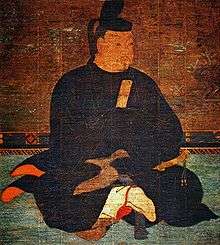 | 34°21′21″N 135°43′14″E | |||
| Descent of Amida Triad with the Six Aspects of Jizō, colour on silk 絹本著色阿弥陀三尊六地蔵来迎図 kenpon chakushoku Amida sanzon roku Jizō raigō zu | Kamakura period | Gojō | Kissho-ji (吉祥寺) | 34°19′33″N 135°41′52″E | ||||
| Ikoma Mandala, colour on silk 絹本著色生駒曼荼羅 kenpon chakushoku Ikoma mandara | 1456 | Ikoma | Ikoma Jinja | 34°40′41″N 135°42′13″E | ||||
| Jukkanshō, ink on paper 紙本墨画十巻抄 shihon bokuga jukkanshō | 1226 | Ikoma | Hōzan-ji | ten handscrolls; a copy of the late-Heian Esoteric Buddhist iconography[55] | .png) | 34°41′05″N 135°41′12″E | ||
| Taima Mandala, colour on silk 絹本著色當麻曼荼羅図 kenpon chakushoku Taima mandara zu | 1674 | Katsuragi | Oku-no-in | 34°31′00″N 135°41′37″E | ||||
| Chūjō-hime, colour on silk 絹本著色中将姫像 kenpon chakushoku Chūjō-hime zō | Kamakura period | Katsuragi | Nakanobō |  | 142.5 centimetres (56.1 in) by 66.3 centimetres (26.1 in) | 34°30′56″N 135°41′44″E | ||
| Pictorial Biography of Shōtoku Taishi, colour on silk 絹本著色聖徳太子絵伝 kenpon chakushoku Shōtoku Taishi e-den | Muromachi period | Nara | National Institutes for Cultural Heritage (kept at Nara National Museum) | pair of scrolls; formerly in the possession of Ōkura-ji (大蔵寺) and kept at the Nara National Museum; acquired by NICH for the Museum in 2017 for ¥40,000,000[56] | 1.jpg) 2.jpg) | 157.8 centimetres (5 ft 2.1 in) to 86.5 centimetres (2 ft 10.1 in) and 157.2 centimetres (5 ft 1.9 in) to 86.7 centimetres (2 ft 10.1 in) | 34°40′59″N 135°50′17″E | |
| Descent of Amida and the Heavenly Retinue, colour on silk 絹本著色阿弥陀聖衆来迎図 kenpon chakushoku Amida shōju raigō zu | Kamakura period | Nara | National Institutes for Cultural Heritage (kept at Nara National Museum) | formerly in the possession of Ōkura-ji (大蔵寺) and kept at the Nara National Museum; acquired by NICH for the Museum in 2017 for ¥50,000,000[56] | .jpg) | 123.1 centimetres (4 ft 0.5 in) to 84.0 centimetres (2 ft 9.1 in) | 34°40′59″N 135°50′17″E | |
| Eight Patriarchs of Shingon, colour on silk 絹本著色真言八祖像 kenpon chakushoku Shingon hasso zō | Kamakura period | Uda | Murō-ji | eight scrolls | 34°32′16″N 136°02′26″E | |||
| Zennyo Ryūō, colour on silk 絹本著色善女龍王図 kenpon chakushoku Zennyo Ryūō zu | Muromachi period | Tawaramoto | Rakuden-ji (楽田寺) | 34°33′10″N 135°47′39″E | ||||
| Mandala of the Two Realms, gold and silver paint on indigo ground 紺地金銀泥両界曼荼羅図 konji kingin dei ryōkai mandara zu | Kamakura period | Takatori | Minami Hokke-ji (南法華寺) | pair of scrolls | 34°26′40″N 135°47′50″E | |||
| Buddha’s Parinirvana, colour on silk 絹本着色仏涅槃図 kenpon chakushoku butsu nehan zu | 1380 | Asuka | Tachibana-dera | 280.5 centimetres (110.4 in) by 206.4 centimetres (81.3 in) | 34°28′12″N 135°49′03″E | |||
| Mandala of the Two Realms, colour on wooden boards 板絵著色両界曼荼羅図 ita-e chakushoku ryōkai mandara zu | 1424 | Kōryō | Daifuku-ji (大福寺) | pair of paintings | 34°33′59″N 135°45′08″E | |||
| Yoshino Mandala, colour on paper 紙本著色吉野曼荼羅 shihon chakushoku Yoshino mandara | Muromachi period | Yoshino | Nyoirin-ji (如意輪寺) | .jpg) | 34°21′52″N 135°52′04″E | |||
Municipal Cultural Properties
Properties designated at a municipal level include:
| Property | Date | Municipality | Ownership | Comments | Image | Dimensions | Coordinates | Ref. |
|---|---|---|---|---|---|---|---|---|
| Kasuga Deities Departing from Kashima Shrine, colour on silk 絹本著色鹿島立神影図 kenpon chakushoku Kashima dachi shin-ei zu | Nanboku-chō/Muromachi period | Nara | Kasuga Taisha | 2.jpg) | 107.6 centimetres (42.4 in) by 39.0 centimetres (15.4 in) | 34°40′53″N 135°50′54″E | ||
| Taima Mandala, colour on silk 絹本著色当麻曼荼羅図 kenpon chakushoku Taima mandara zu | Kamakura period | Nara | Raikō-ji (来迎寺) | .jpg) | 166.3 centimetres (65.5 in) by 152.9 centimetres (60.2 in) | 34°35′36″N 135°56′48″E | ||
| Tosō Tenjin, colour on silk 絹本著色渡宋天神像 kenpon chakushoku Tosō Tenjin zō | early/mid-C15 | Nara | Sugawara Tenmangū (菅原天満宮) (kept at Nara National Museum) | holding a branch of plum blossoms; with gasan or accompanying text by Gukyoku Reisai (愚極礼才) (1370-1452)[57] | .jpg) | 88.6 centimetres (34.9 in) by 33.0 centimetres (13.0 in) | 34°40′59″N 135°50′17″E | |
| Eison (Kōshō Bosatsu), colour on silk 絹本著色興正菩薩像 kenpon chakushoku Kōshō Bosatsu zō | Kamakura period | Nara | Saidai-ji (kept at Nara National Museum) | 34°40′59″N 135°50′17″E | ||||
| Eison (Kōshō Bosatsu), colour on silk 絹本著色興正菩薩像 kenpon chakushoku Kōshō Bosatsu zō | Kamakura period | Nara | Tōshōdai-ji | 34°40′32″N 135°47′05″E | ||||
| Shinkū, colour on silk 絹本著色慈真和尚像 kenpon chakushoku Jishin oshō zō | Kamakura period | Nara | Hokke-ji | 34°41′33″N 135°48′15″E | ||||
| Legends of Yata Jizō, colour on paper 紙本著色矢田地蔵縁起 shihon chakushoku Yata Jizō engi | Muromachi period | Nara | private | one scroll | 34°42′17″N 135°44′03″E | |||
| Kasuga Gongen Genkidai 春日権現験記台 Kasuga Gongen genkidai | Kamakura period | Nara | Kasuga Taisha | six panels | 34°40′53″N 135°50′48″E | |||
| Tsutsui Junkei, colour on silk 絹本著色筒井順慶像 kenpon chakushoku Tsutsui Junkei zō | Momoyama period | Nara | Denkō-ji (伝香寺) | 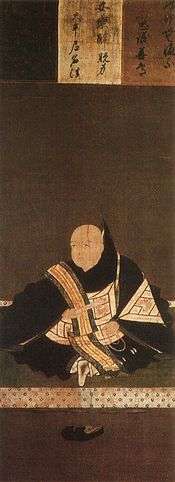 | 110.4 centimetres (43.5 in) by 41.1 centimetres (16.2 in) | 34°40′50″N 135°49′33″E | ||
| Town and Country, emaki 絹本著色都鄙図巻 kenpon chakushoku tohizu maki | Edo period | Nara | Konbu-in (興福院) (kept at Nara National Museum) | 1 scroll | 34°40′59″N 135°50′17″E | |||
| Congratulating Empress Meishō on her 70th Birthday, colour on paper with gold ground, byōbu 紙本金地著色明正院七十賀月次絵屏風 shihon kinji chakushoku Meishō-in nanajū ga getsuji e byōbu | Edo period | Nara | Enshō-ji | pair of six-panel screens |   | 34°38′37″N 135°50′44″E | ||
| Grazing in Springtime and Autumn Fields, colour on paper, byōbu 紙本著色春郊放牧・田園秋色図屏風 shihon chakushoku shunkō hōboku denen shūshoku zu byōbu | Edo period | Nara | Enshō-ji | pair of six-panel screens | 34°38′37″N 135°50′44″E | |||
| Tamaya Partition Paintings 霊屋障壁画 Tamaya shōhekiga | mid-Edo period | Kyoto | Konbu-in (興福院) (kept at Kyoto National Museum) | 20 panels by Watanabe Shikō (渡辺始興) | .jpg) | 34°59′24″N 135°46′23″E | ||
| Former Fukuju-in Partition Paintings, by Nagasawa Rosetsu 旧福寿院障壁画 長沢芦雪筆 kyū Fukuju-in shōhekiga Nagasawa Rosetsu hitsu | late-C18 | Nara | Yakushi-ji (kept at Nara National Museum) | 29 panels | .jpg) | 34°40′59″N 135°50′17″E | ||
| Ema with Storage Box 絵馬板附収納箱 ema-ban tsuketari shūnōbako | Muromachi period | Nara | Kasuga Taisha | 5 ema | 34°40′50″N 135°50′37″E | |||
| Toyotomi Hidenaga 豊臣秀長画像 Toyotomi Hidenaga gazō | Edo period | Yamatokōriyama | Shungakuin (春岳院) |  | 118 centimetres (46 in) by 55 centimetres (22 in) | 34°39′03″N 135°47′03″E | ||
| Yanagisawa Yoshiyasu 柳澤吉保画像 Yanagisawa Yoshiyasu gazō | Edo period | Yamatokōriyama | private | |||||
| Rikugi-en, emaki 六義園絵巻 Rikugi-en, emaki | Edo period | Yamatokōriyama | Yanagisawa Bunko (柳沢文庫) | 3 scrolls | 34°39′04″N 135°46′49″E | |||
| View of Kōriyama Castle 郡山城の図(享保9年) Kōriyama-jō no zu (Kyōhō 9-nen) | 1724 | Yamatokōriyama | Yanagisawa Bunko (柳沢文庫) | 34°39′04″N 135°46′49″E | ||||
| View of Kōriyama Castle 郡山城の図(安政年間) Kōriyama-jō no zu (Ansei nenkan) | 1854-60 | Yamatokōriyama | Yanagisawa Bunko (柳沢文庫) | 34°39′04″N 135°46′49″E | ||||
| Maps of the Town Divisions 町割図 machi wari zu | Edo period | Yamatokōriyama | Yanagisawa Bunko (柳沢文庫) | 29 items | 34°39′04″N 135°46′49″E | |||
| Map of Residences with Roads and Names 御家中屋敷小路割名前図 Gokachū Nakayashiki kōji wari namae-zu | Edo period | Yamatokōriyama | Yanagisawa Bunko (柳沢文庫) | 34°39′04″N 135°46′49″E | ||||
| Old View of Kōriyama Castle 郡山城古図 Kōriyama-jō kozu | Edo period | Yamatokōriyama | Hatsushi-in (発志院) | 34°38′50″N 135°45′39″E | ||||
| Kasuga Akadōji, colour on silk 絹本著色春日赤童子画像 kenpon chakushoku Kasuga Akadōji gazō | 1488 | Yamatokōriyama | Uetsuki Jinja (植槻神社) | .jpg) | 73.9 centimetres (29.1 in) by 31.5 centimetres (12.4 in) | 34°39′14″N 135°46′54″E | ||
| Occurrences of Kasuga Festival 春日御祭之次第(上下巻) Kasuga omatsuri no shidai (jōgekan) | Edo period | Yamatokōriyama | Yanagisawa Bunko (柳沢文庫) | two scrolls | 34°39′04″N 135°46′49″E | |||
| Illustrated Legends of Uetsuki Dōjō, emaki 植槻道場縁起絵巻 Uetsuki dōjō engi emaki | Edo period | Yamatokōriyama | Uetsuki Jinja (植槻神社) | 1 scroll | 34°39′14″N 135°46′54″E | |||
| Chinese Lions, fusuma 唐獅子図戸襖絵 karajishi zu to fusuma-e | 1761 | Yamatokōriyama | Yakuon Hachiman Jinja (薬園八幡神社) | 8 panels | .jpg) | 180 centimetres (71 in) by 97 centimetres (38 in) | 34°38′48″N 135°47′13″E | |
See also
References
- "Cultural Properties for Future Generations". Agency for Cultural Affairs. Retrieved 25 August 2019.
- 国宝・重要文化財 [Number of National Treasures and Important Cultural Properties by Prefecture] (in Japanese). Agency for Cultural Affairs. 1 July 2019. Retrieved 25 August 2019.
- "Database of National Cultural Properties: 国宝・重要文化財(美術品)(絵画 奈良県)" (in Japanese). Agency for Cultural Affairs. Archived from the original on 30 June 2019. Retrieved 25 August 2019.
- 文化財指定件数 [Number of Designated Cultural Properties] (PDF) (in Japanese). Nara Prefecture. 1 April 2018. Retrieved 25 August 2019.
- "Hue of the Water, Light on the Peaks". National Institutes for Cultural Heritage. Retrieved 23 June 2014.
- Ahn Hwi-Hoon. "Koreana: Joseon Prince's Dream Journey to Peach Orchard Paradise". Korea Foundation. Retrieved 23 June 2014.
- "Portrait of Ando En'e". National Institutes for Cultural Heritage. Retrieved 28 June 2014.
- "Mandala of the One-Syllable Golden Wheel (Skt., Ekaksarosnisacakra), (J., Ichiji Kinrin Mandara)". National Institutes for Cultural Heritage. Retrieved 29 June 2014.
- "Ichijikinrin 一字金輪". Japanese Architecture and Art Net Users System. Retrieved 29 June 2013.
- "Kokuzo (Akasagarbha)". National Institutes for Cultural Heritage. Retrieved 30 June 2014.
- "Mandalas of the Two Worlds (Ryokai Mandara); Sword with the Dragon Kurikara (Kulika Nagaraja) and Two Child Acolytes". National Institutes for Cultural Heritage. Retrieved 3 September 2015.
- "Monju (Manjusri)". National Institutes for Cultural Heritage. Retrieved 3 September 2015.
- "Five Great Myoo (Vidyarajas)". National Institutes for Cultural Heritage. Retrieved 30 June 2014.
- http://www.kohfukuji.com/property/cultural/041.html [Images of Jion Daishi] (in Japanese). Kōfuku-ji. Retrieved 25 August 2019.
- "Sakyamuni Triad". National Institutes for Cultural Heritage. Retrieved 3 September 2015.
- "Sakyamuni Preaching on Vulture Peak". National Institutes for Cultural Heritage. Retrieved 3 September 2015.
- "Ten Kings of Hell". National Institutes for Cultural Heritage. Retrieved 4 September 2015.
- "Ten Kings of Hell". National Institutes for Cultural Heritage. Retrieved 4 September 2015.
- "Twelve Heavenly Deities (Devas)". National Institutes for Cultural Heritage. Retrieved 4 September 2015.
- "Mandala of the Pure Land of Amida (Amitabha), (J., Amida Jodo Mandara)". National Institutes for Cultural Heritage. Retrieved 4 September 2015.
- "Portrait of the Priest Shinran". National Institutes for Cultural Heritage. Retrieved 4 September 2015.
- "Mandala of Ikoma Shrine". National Institutes for Cultural Heritage. Retrieved 4 September 2015.
- "Thousand-Armed Kannon (Sahasrabhuja)". National Institutes for Cultural Heritage. Retrieved 4 September 2015.
- "Mandala of the Supreme Usnisa Buddhas (J., Sonsho Mandara)". National Institutes for Cultural Heritage. Retrieved 4 September 2015.
- "Mandala of the Great Cranial Protuberance (Skt., Mahosnisacakra), (J., Daibutcho・Mandara)". National Institutes for Cultural Heritage. Retrieved 4 September 2015.
- "Jizo (Ksitigarbha)". National Institutes for Cultural Heritage. Retrieved 30 June 2014.
- "Jizo (Ksitigarbha)". National Institutes for Cultural Heritage. Retrieved 30 June 2014.
- "Portrait of the Priest Daoxuan (Dosen)". National Institutes for Cultural Heritage. Retrieved 5 September 2015.
- "White Path to Paradise between Two Rivers of Worldly Vice (J., Nika Byakudo Zu)". National Institutes for Cultural Heritage. Retrieved 5 September 2015.
- "Mandala of Sanno Shrine (J., Sanno-Miya Mandara)". National Institutes for Cultural Heritage. Retrieved 5 September 2015.
- "Nyoirin Kannon (Cintamanicakra)". National Institutes for Cultural Heritage. Retrieved 28 June 2014.
- "Byakue Kannon". Japanese Architecture and Art Net Users System. Retrieved 23 June 2014.
- 白衣観音像 [Byakue Kannon] (in Japanese). Nara National Museum. Retrieved 23 June 2014.
- "White-Robed Kannon (Pandaravasini)". National Institutes for Cultural Heritage. Retrieved 23 June 2014.
- "Fudo Myoo (Acalanatha) and Eight Child Acolytes (Kumaras)". National Institutes for Cultural Heritage. Retrieved 5 September 2015.
- "Fugen Enmei (Vajramoghasamayasattva)". National Institutes for Cultural Heritage. Retrieved 5 September 2015.
- "Fugen (Samantabhadra) and Ten Rasetsunyo (Raksasis)". National Institutes for Cultural Heritage. Retrieved 5 September 2015.
- "Fugen (Samantabhadra)". National Institutes for Cultural Heritage. Retrieved 28 June 2014.
- "Nirvana (Death) of the Buddha". National Institutes for Cultural Heritage. Retrieved 5 September 2015.
- "Portrait of the Priest Myoku". National Institutes for Cultural Heritage. Retrieved 5 September 2015.
- "Shrine with Mandalas of the Two Worlds (Ryokai Mandara)". National Institutes for Cultural Heritage. Retrieved 5 September 2015.
- "Water Moon Kannon (Avalokitesvara)". National Institutes for Cultural Heritage. Retrieved 5 September 2015.
- "White-Robed Kannon (Pandaravasini)". National Institutes for Cultural Heritage. Retrieved 5 September 2015.
- "Sudhana's Pilgrimage to Fifty-five Spiritual Teachers as Described in the Flower Ornament Scripture (Avatamsaka Sutra), (J., Kegon Gojugosho E), (Scene of Sudhana Meeting Upasika)". National Institutes for Cultural Heritage. Retrieved 5 September 2015.
- "Illustrated Sutra of Cause and Effect (J., E-inga Kyo)". National Institutes for Cultural Heritage. Retrieved 5 September 2015.
- "Monk-in-Hell Scroll (Hell of boiling excrement)". National Institutes for Cultural Heritage. Retrieved 5 September 2015.
- "Iconographic Drawings of Kannon (Avalokitesvara)". National Institutes for Cultural Heritage. Retrieved 7 September 2015.
- "Todai-ji Kaidan-in Tobira Ezu (Painting for the doors of Kaidan-in of Todai-ji temple)". National Institutes for Cultural Heritage. Retrieved 7 September 2015.
- "Iconographic Drawings of Fudo Myoo (J., Fudo Giki)". National Institutes for Cultural Heritage. Retrieved 7 September 2015.
- "Iconographic Drawings of the Womb World Mandala (J., Taizo Zuzo)". National Institutes for Cultural Heritage. Retrieved 7 September 2015.
- "Portrait of the Priest Daido Ichii". National Institutes for Cultural Heritage. Retrieved 4 September 2015.
- "Thousand-Armed Kannon (Sahasrabhuja); Kannon (Avalokitesvara)". National Institutes for Cultural Heritage. Retrieved 22 June 2014.
- 奈良県指定文化財一覧 [List of Nara Prefectural Cultural Properties] (in Japanese). Nara Prefecture. 1 April 2015. Retrieved 4 September 2015.
- 都道府県別指定等文化財件数(都道府県分) [Number of Prefectural Cultural Properties by Prefecture] (in Japanese). Agency for Cultural Affairs. 1 May 2014. Retrieved 3 September 2015.
- 宝山寺十巻抄 [Jukkansho from Hozanji]. Ikoma City. Retrieved 4 September 2015.
- 平成29年度購入文化財一覧 [List of Cultural Properties Acquired in 2017] (PDF) (in Japanese). National Institutes for Cultural Heritage. Retrieved 25 August 2019.
- "gasan". Japanese Architecture and Art Net Users System. Retrieved 28 June 2014.
External links
- (in Japanese) Cultural Properties in Nara Prefecture
- (in English) Image Database of Historical Resources of the Nara Region
This article is issued from Wikipedia. The text is licensed under Creative Commons - Attribution - Sharealike. Additional terms may apply for the media files.